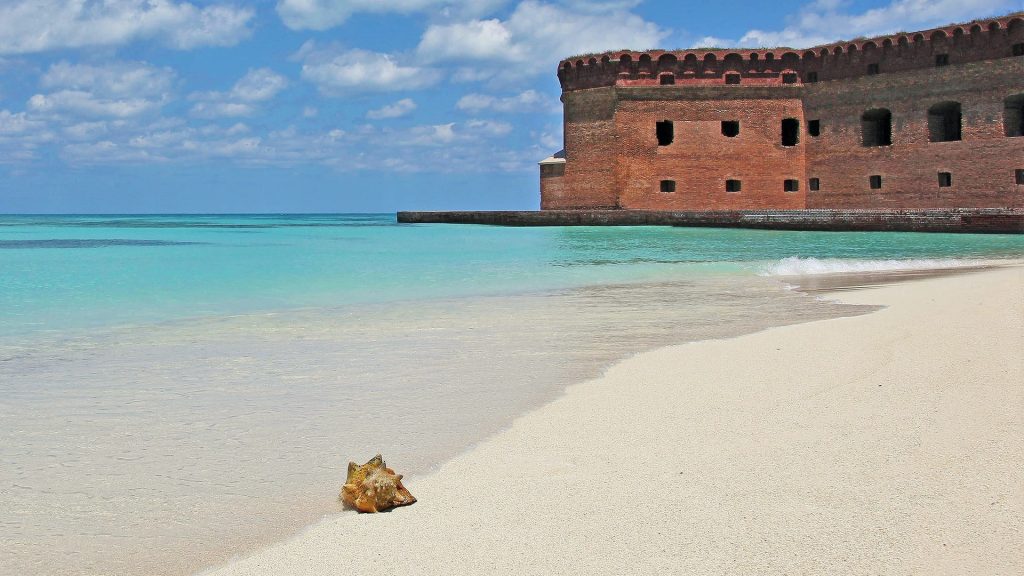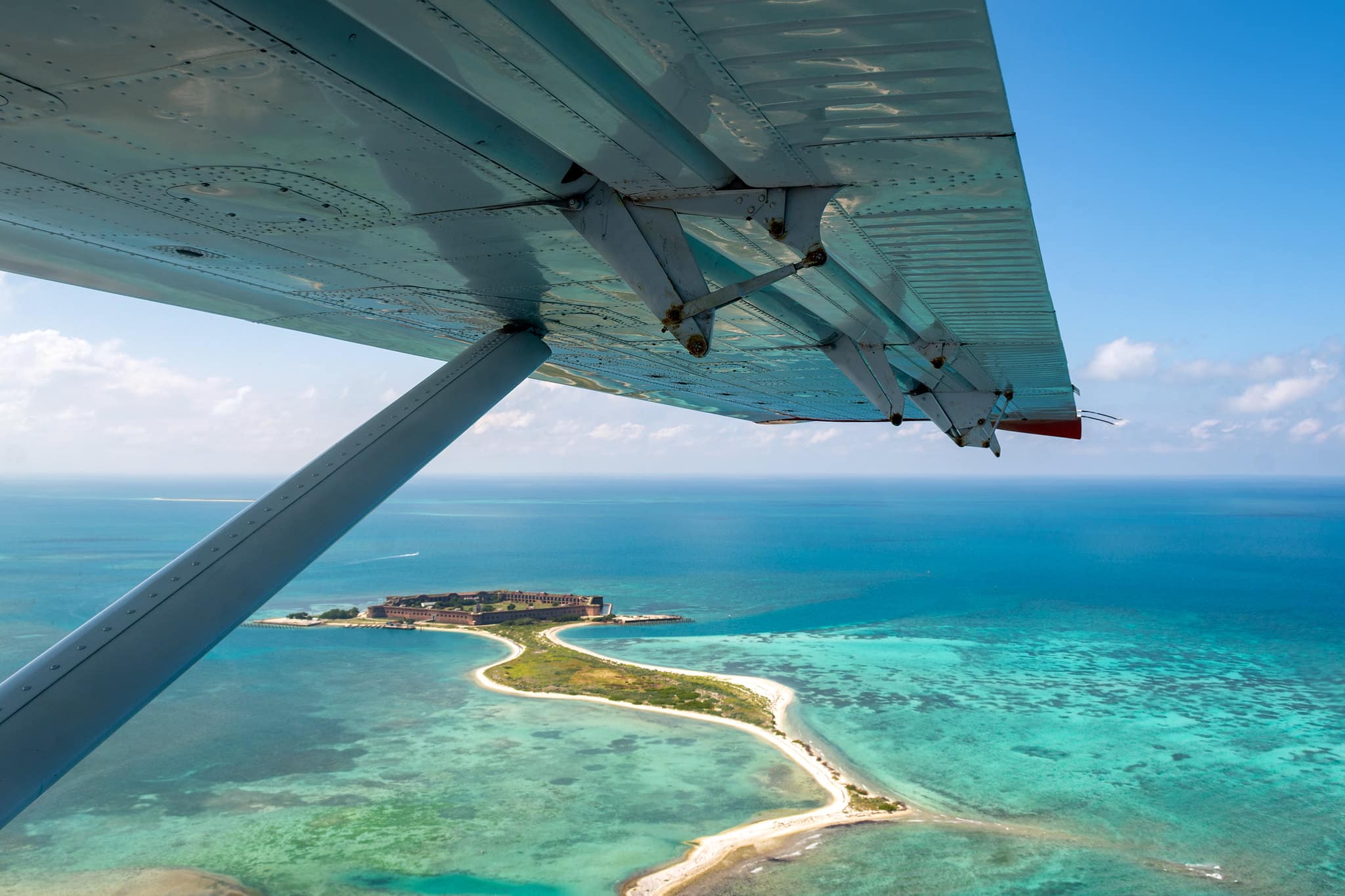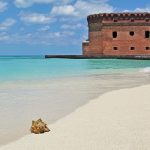How to Travel to the Dry Tortugas National Park
Roughly 68 miles west of the Florida Keys sits a cluster of seven islands comprised of coral and sand, that are collectively known as the Dry Tortugas. Originally named Las Tortugas (Spanish for “the turtles”), the islands were eventually known as the Dry Tortugas due to their lack of fresh water.
The Dry Tortugas National Park is one of the most remote national parks of the National Park Service, and is listed in the National Register of Historic Places.
Where is the Dry Tortugas National Park?
Dry Tortugas National Park is located in the Gulf of Mexico, about 70 miles west of Key West, Florida. The best airport to fly into for a visit to the park is Key West International Airport (EYW), located in Key West, Florida. From there, you can take a ferry or seaplane to reach the park, or arrange for a private charter boat.
Alternatively, you can fly into Ft. Lauderdale (4 hour drive to the Key West Seaport), Miami International [MIA] (3.5 hour drive to the seaport) if you’d like to do some extra driving and exploring before your visit the Dry Tortugas.
Can you stay at the Dry Tortugas?
If you’re looking to spend the night at Dry Tortugas National Park, your only option is camping. The park offers camping facilities for visitors, but due to its limited space, reservations ($15 a night) must be made well in advance online. Only 10 camping spots are available, so it’s important to plan ahead if you’re interested in this experience. The largest camp site on the islands can accommodate 10-40 people for slightly more.
If camping isn’t for you, then you must stay outside the park, typically in nearby Key West, Marathon, or a similar location. Unfortunately, the cost of lodging in Key West can be quite high, making it usually the most expensive part of a trip to the Dry Tortugas.
Are amenities are on the Dry Tortugas?
Dry Tortugas National Park offers limited amenities for visitors. There is the small Garden Key Visitor Center inside the fort that primarily provides informational books, brochures, and a movie about the Fort’s history. The park also has restrooms, but there are no restaurants or shops available on the island. If you’re planning to visit, it’s a good idea to bring your own food and drinks, as well as any other necessary supplies.
What is there to do at the Dry Tortugas?

The Dry Tortugas National Park offers a variety of activities for visitors to enjoy. Snorkeling and swimming are popular options for those looking to explore the marine life and coral reefs in the surrounding waters. Guided tours by park rangers are also available, providing visitors with an opportunity to learn about the history of the park and its attractions, including historic Fort Jefferson.
The Fort itself is the main attraction in the park, offering a glimpse into its history as a former Civil War military prison. It is the largest brick structure in the Americas, and is surrounded by a moat wall. Visitors can take a tour of the Fort to learn about its past and explore its various rooms and courtyards. The fort is open all year, but only during daylight hours.
In addition to its rich history and marine life, the Dry Tortugas also offers a pristine beach with abundant coral and shells. However, visitors should be aware that the sand is not as soft as one might expect and that it is recommended to bring water shoes for comfort.
Are there any concerns with traveling to the Dry Tortugas?
Visiting the Dry Tortugas National Park can present some concerns for travelers. One of the most notable is the recent arrival of Cuban migrants on boats, which temporarily closed the park to tourists.
Additionally, the park is susceptible to weather-related problems, such as hurricanes, that can impact visitors’ plans. The Atlantic hurricane season runs from June 1st to November 30th.
Another concern for travelers to the Dry Tortugas is the intense heat and lack of shade, except for inside Fort Jefferson. Visitors should come prepared with sunscreen, hats, and plenty of water to stay hydrated during their visit.
What are the best months to travel to the Dry Tortugas?
The Dry Tortugas have subtropical weather, which ranges from 60-90 F. The summers are hot and humid, with hurricane season stretching from June into November. Winters are dry with mild temperatures, but windy and choppy seas. The water is relatively chilly in January, but probably still better than 95% of the US at the same time.
How do you get to Dry Tortugas?

When visiting the Dry Tortugas National Park, there are several options for travel, including the Yankee Freedom Ferry, sea plane, chartered boats, or on your own private boat (permit required). While there is only one ferry option and one seaplane company authorized to travel to the islands, visitors have the flexibility to choose the mode of transportation that best suits their needs. It is important to note that both the ferry and seaplane options are round-trip fares, meaning that it is not possible to take the ferry in and the seaplane out, or vice versa.
In addition to the cost of transportation, visitors should also budget for parking fees on Key West, which are roughly $50 per day, regardless of the mode of island transportation used. There is also a $15 fee to enter the National Park.
By Plane
The seaplane option to Dry Tortugas National Park is a quicker and more expensive alternative to the ferry, but it provides a smoother and much more enjoyable ride. This is my preference if you can swing the added cost. It is such a better option!
With fantastic views, this option allows for more time to be spent at the park, as the shorter travel time means less time spent on the journey. However, the seaplane does not provide food and beverages like the ferry, so it is important to bring your own supplies. The seaplane ride is 45 minutes from loading to unloading, with a flight time of approximately 35 minutes each way. There are two flight options available, half-day and full-day. I think the half day trip is sufficient since the park is relatively small, assuming you don’t plan on snorkeling.
The seaplane will charge the Park’s entrance fee upon arrival, cash only.
The only authorized charter plane to travel to the Dry Tortugas National Park is Key West Sea Plane Charters. However, it is worth noting that seaplanes are more likely to get cancelled than ferries, usually due to high seas or wind conditions.
By Ferry
The park can be reached by taking the Dry Tortugas Ferry, called Yankee Freedom Ferry, which also departs from Key West. The ferry schedule runs daily from 10am-3pm. The ferry tickets include the cost of entrance to the park, but NOT camping fees.
This is a cost-effective option, although the journey can be long and rough, with swells reaching 1-3 feet, leading to frequent cases of seasickness. Despite this, the ferry rarely gets cancelled, making it a reliable mode of transport. With limited outside seating, I recommend that you arrive early to secure the best seats. The views from the Ferry may not be great, but we’ve been able to spot loggerhead sea turtles and schools of fish, often from the sides of the boat.
A day trip on the ferry costs around $200 per person, with senior discounts available (including one for having a National Park season pass). The trip takes 2.5 hours each way and includes breakfast and lunch, as well as free use of snorkeling gear. To ensure a spot on the ferry, it is recommended to make a reservation at least a month in advance. The ferry also has a bar for those who would like to relax with drinks.
Last Minute Ferry Ticket Options
Admission to the ferry is on a first come, first serve basis for those looking to buy a ticket the day of (i.e. without a reservation). Get in line early the day you’d like to visit the national park – usually 3-4am, but no later than 5:30am – to signup for standby access. Check-in is at 7:00 am, so you need to be there well before then. Occasionally, there are cancellations or no shows on a day when the weather is less than ideal. I’ve heard stories of the entire standby line getting in on some days, then no one the next. The ferry allows customers to defer their day for various reasons. If there are no shows, or people defer, the people on standby are taken on a first-come basis.
Tickets may also become available for purchase on the ferry’s website when someone cancels, so it is recommended to check the website frequently, especially as the day of the trip approaches.







